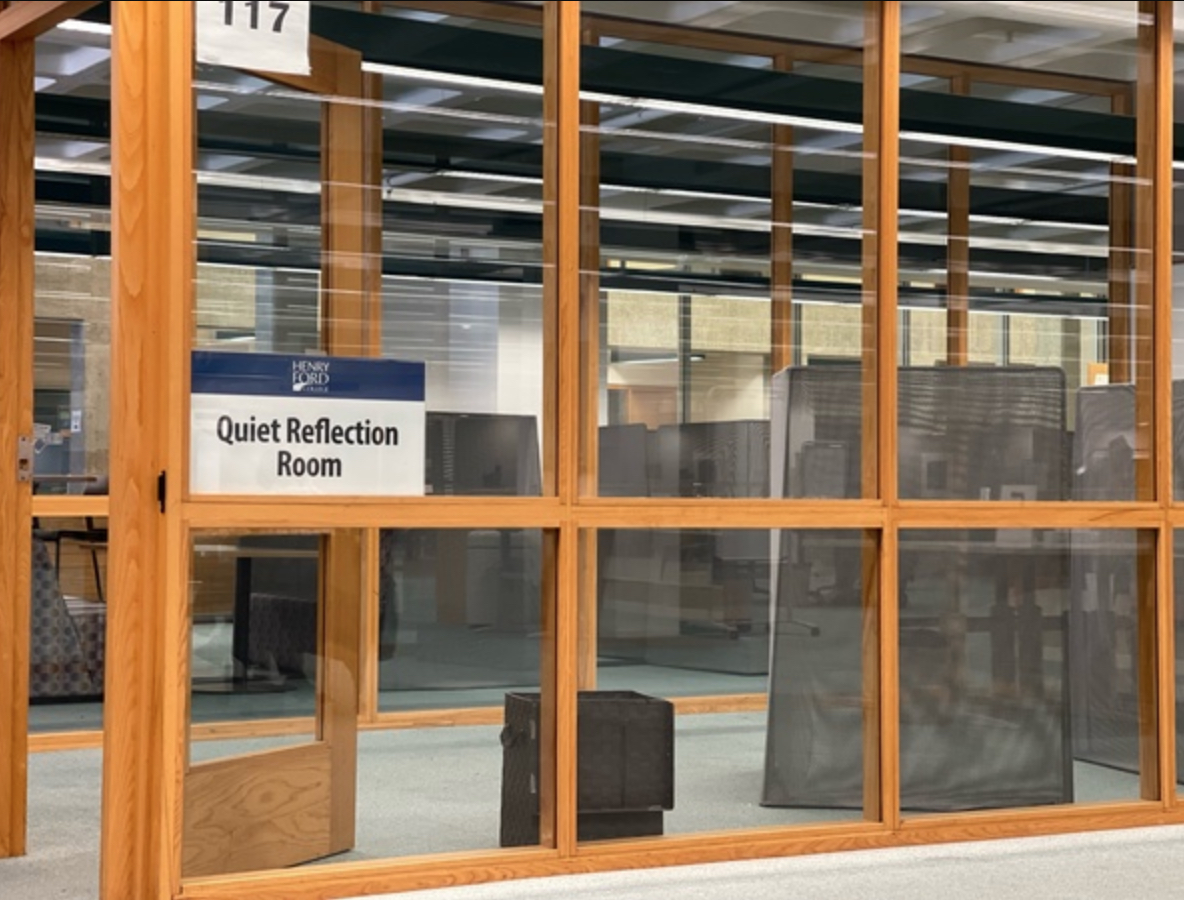Temporary Relocation of the Quiet Reflection Room
Gallery

Quiet Reflection Room temporary location first floor Eshleman Library Henry Ford College photo by Ali Seblini
Henry Ford College’s quiet reflection room, where students can pray, meditate, or have a quiet place to think, has been temporarily moved to the first floor of the Eshleman Library while the second floor undergoes renovations. The space occupies room B-117 on the main floor and is identified by the sign that says “Quiet Reflection Room.”
Religion plays an important role in the lives of many, which is why Henry Ford College tries to accommodate the religious practices of its students. According to the director of Student Activities, Cassandra Fluker, “HFC is a welcoming campus with the understanding that needs vary for our diverse student body, and we are here to help students succeed.” One way the college meets these needs is by providing a quiet reflection room within the Eshleman Library, in building “B.” The quiet reflection room offers a silent and undisturbed area for students who want to reflect.
When the pandemic began, the quiet reflection room was closed along with the rest of the campus. “Now that the college is gradually opening and more in-person classes are offered, more students are on campus, the Quiet Reflection Room has reopened to accommodate the campus community with a space for mediation,” says Fluker.
The room has had a lot of history at HFC. It has been relocated a number of times. The idea for such a room was introduced over two decades ago. “Space for prayer became an issue at Henry Ford College shortly after the 9/11 tragedy when students began to pray on campus in conspicuous places,” says Fluker. The initial location of the reflection room was inside of the Health Careers Education Center. This location, however, was only temporary due to an agreement that “offered the room on a term-by-term basis.” The room was available for use until the end of December 2008, when the space was needed for a lab for the Ophthalmic Technician Program.
Soon after, HFC partnered with the Gabriel Richard Center, located on the campus of the University of Michigan-Dearborn, and agreed to create a space for meditation. “HFC students of the Islamic faith had expressed dislike of the arrangement because of limited time between classes and the differences in religions. Consequently, students chose not to visit the center for prayer,” says Fluker.
So, in the Winter 2010 term, in order to make the room more accessible and inclusive, space was allocated within the student clubs room, M-109, in the Student and Culinary Arts Center, for students to meditate and pray. Unfortunately, this space, with all the commotion surrounding it, wasn’t suitable. According to Fluker, “Ultimately, the area was not conducive for prayer because of the ongoing traffic, noise level, and student leaders needing to occupy the space for event planning.” The reflection room was then moved down the hallway to room M-111 at the beginning of Winter 2016. While M-111 had more privacy, this room wasn’t enough to meet the needs of every student needing to use it. Also, there was still the ongoing issue of noise disturbing users of the reflection room. “With more students occupying the room, that space eventually became too small, and it was in a high-traffic area with lots of noise,” says Fluker.
After some careful consideration, the HFC Operations Council decided to permanently relocate the reflection room to the Eshleman Library. The Council considered it “a suitable space for students, faculty, and staff to reflect, meditate, and pray,” according to Fluker. The room has been in the library since the Fall 2018 term.
Having multiple reflection rooms or spaces around campus could be more accessible and convenient for HFC students, but that is not yet achievable. “Currently, it is not feasible to provide space in every building around campus for the purpose of meditation,” says Fluker. “Space is limited at HFC and has been an ongoing campus-wide concern for many years. Many academic areas need, or desire, expanded space for their programs.” Fluker adds, “In addition, safety is an issue. A quiet reflection room should be an open and quiet space, large enough to accommodate many students, and sectioned off with glass panels and/or doors with windows for easy monitoring. That type of space does not exist in all campus buildings.“
The quiet reflection room in the Eshleman Library will continue to provide a centrally located, undisturbed space for meditation, reflection, and prayer. It’s a space that every HFC student has access to and should be informed of.
Fluker says, “Students who are spotted praying or meditating in stairwells or other places may not know about the Quiet Reflection Room located in the library. In this case, two ideas come to mind in addressing the situation, 1) there may be a need for the college to increase avenues of communications to ensure that students are aware of the service, and 2) I like to use Campus Safety’s motto, ‘If you see something, say something!’” Fluker adds, “If a student is praying or meditating in a space not designated for that purpose, whoever is a witness, if comfortable, can pleasantly inform the student of the Quiet Reflection Room or inform HFC personnel to address the concern.”
The quiet reflection room is currently located on the first floor of the Eshleman Library and is open Monday through Thursday from 8 a.m. to 4:30 p.m., and Friday from 8 a.m. to 1 p.m.
